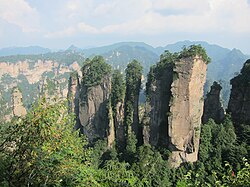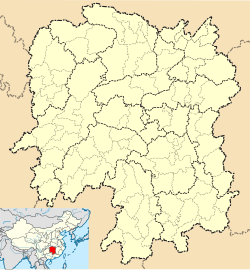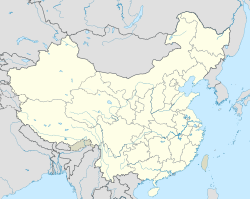Zhangjiajie
Zhangjiajie
张家界市 Zanxjiaxgaif Tayung | |
|---|---|
 | |
| Nickname: Dayong | |
 Location of Zhangjiajie City jurisdiction in Hunan | |
| Coordinates (Zhangjiajie municipal government): 29°07′01″N 110°28′44″E / 29.117°N 110.479°E | |
| Country | People's Republic of China |
| Province | Hunan |
| Area | |
| • Prefecture-level city | 9,518 km2 (3,675 sq mi) |
| • Urban (2017)[1] | 55.20 km2 (21.31 sq mi) |
| • Districts[1] | 2,571.3 km2 (992.8 sq mi) |
| Population (2010) | |
| • Prefecture-level city | 1,476,521 |
| • Density | 160/km2 (400/sq mi) |
| • Urban (2017)[1] | 225,700 |
| • Districts[1] | 584,000 |
| GDP[2] | |
| • Prefecture-level city | CN¥ 44.8 billion US$ 7.2 billion |
| • Per capita | CN¥ 29,425 US$ 4,724 |
| Time zone | UTC+8 (China Standard) |
| ISO 3166 code | CN-HN-08 |
| Website | www |
| Zhangjiajie | |||||||||||
|---|---|---|---|---|---|---|---|---|---|---|---|
 "Zhangjiajie" in Simplified (top) and Traditional (bottom) Chinese characters | |||||||||||
| Simplified Chinese | 张家界 | ||||||||||
| Traditional Chinese | 張家界 | ||||||||||
| Postal | Changkiakai Tayung (until 1994) | ||||||||||
| |||||||||||
| Dayong | |||||||||
|---|---|---|---|---|---|---|---|---|---|
| Chinese | 大庸 | ||||||||
| Postal | Tayung | ||||||||
| |||||||||
Zhangjiajie (simplified Chinese: 张家界; traditional Chinese: 張家界; pinyin: Zhāngjiājiè; Tujia: Zanxjiaxgaif /tsán tɕá kǎi/), is a prefecture-level city in the northwestern part of Hunan Province, China. It comprises the district of Yongding, Wulingyuan and counties of Cili and Sangzhi. It contains the Zhangjiajie National Forest Park, part of the Wulingyuan Scenic Area which was designated as a UNESCO World Heritage Site in 1992.[3]
History

The city itself was previously named Dayong (大庸) and has a recorded history dating back to 221 BC.[4] People lived here along both banks of the Lishui River (the mother river in Zhangjiajie), now within the boundaries of Zhangjiajie City, very early during the Stone Age. Human settlement in this region dates back 100,000 years, rivaling famous sites such as Xi'an, Beijing and others. In 1986, the Academy of Chinese Social Science discovered Stone Age relics in Cili County, unearthing 108 articles of stoneware; mostly tapered-form, hacked-tamped and plate-shaped works. Shortly thereafter, in 1988, the Archaeological Institute of the Hunan Province found other relics in Sangzhi County, including three pieces of stoneware that were estimated to have been fashioned over around the same time period.[5]
Ten thousand years ago, those who lived within the boundaries of what is now Zhangjiajie City employed fire to bake pottery.[5] Archaeologists have found more than 20 relics of this kind in the Cili County. While in Sangzhi County, a black clay pot adorned with a unique design was unearthed dating back ten thousand years. During that period, this pottery-firing technique was the most advanced in China. These technological advancements in the fashioning of stone tools and pottery would seem to indicate a highly developed culture in this region. However, the society which developed only endured briefly before waning and being superseded by other regional powers. This seems understandable in view of Zhangjiajie's remote geographical position, its undeveloped land and river transportation and its mountainous terrain making cultivation difficult. For these reasons, Zhangjiajie has been labeled "the Land of the Savage Southern Minority" since the earliest recorded history. Additional name descriptors have been the "Wuling Rude People" and "Tujia Rude People", indicative of discriminatory views held against the regional culture.[6]
Origin of the name


The new name of Zhangjiajie City was adopted in 1994, after the National Forest Park in the Wulingyuan Scenic Area in order to give it more prominence and after this site had been designated a UNESCO World Heritage Site in 1992. The National Forest Park had been given the name of Zhangjiajie after the name of a small village located within its bounds and now a popular tourist attraction within the park. The three-character name (张家界) can be interpreted as follows: "Zhang" (张) is a common surname in China; "jia" (家) can be translated as "family" and "jie" (界) can be translated as "homeland", giving the completed translation of "Zhang family homeland." It has been reported that at least one tourist guide has said that the name may have been chosen to convey the idea or impression of "Open the family door to welcome the world" (张开家门引进世界), but this is not the locally accepted and directly-translated meaning of the name. The official version of its name is linked to a Han general and advisor, Zhang Liang, who resettled in the area after a suspicious Liu Bang, the founder of Han dynasty, started to persecute his staffs and generals who had contributed to his becoming emperor. It was so named to signify that the Zhang family had set up home there.[7]
"jie" in the city has two meanings: one refers to the boundary of ownership, the other refers to high mountains. The Daoguang edition of the Qing Dynasty "Annals of Yongding County" contained: "Wudong Stream originated in Zhangjiajie." Republic of China edition of "Cili County records" contained: "Suoxi from Zhangjiajie." Here Zhangjiajie, refers to the Zhangjiajie National Forest Park area. Zhangjiajie's name, the earliest in the Ming Chongzhen four years (1631) "Zhang Genealogy" preface. The preface was written by Zhang Zaichang, the sixth grandson of Zhang Wancong, commander of Yongding Wei Dayong Office. During the reign of Hongzhi of the Ming Dynasty (1488–1506), the imperial court, seeing Zhang Wancong's meritorious service in guarding the town, awarded him the "mountain land" around the Zhangjiajie National Forest Park as a fief. He then moved his family up the mountain to maintain the business. Ming Chongzhen three years (1630), the sixth generation of Zhang Wancong's grandson Zhang Zaihong was given a regiment officer, and set up a government office here. This area became the hereditary territory of the Zhang family, called "Zhangjiajie".
Administrative subdivisions
Zhangjiajie administers two districts and two counties.
- Yongding District (永定区) (which contains the central, built-up area of Zhangjiajie city)
- Wulingyuan District (武陵源区)
- Cili County (慈利县)
- Sangzhi County (桑植县)
| Map |
|---|
Climate
| Climate data for Zhangjiajie (1991–2020 normals, extremes 1981–2010) | |||||||||||||
|---|---|---|---|---|---|---|---|---|---|---|---|---|---|
| Month | Jan | Feb | Mar | Apr | May | Jun | Jul | Aug | Sep | Oct | Nov | Dec | Year |
| Record high °C (°F) | 21.8 (71.2) |
29.4 (84.9) |
33.9 (93.0) |
38.2 (100.8) |
37.0 (98.6) |
38.8 (101.8) |
40.8 (105.4) |
41.2 (106.2) |
38.6 (101.5) |
35.5 (95.9) |
30.0 (86.0) |
23.9 (75.0) |
41.2 (106.2) |
| Mean daily maximum °C (°F) | 9.5 (49.1) |
12.2 (54.0) |
17.0 (62.6) |
23.4 (74.1) |
27.4 (81.3) |
30.5 (86.9) |
33.5 (92.3) |
33.6 (92.5) |
29.4 (84.9) |
23.3 (73.9) |
17.9 (64.2) |
12.2 (54.0) |
22.5 (72.5) |
| Daily mean °C (°F) | 5.6 (42.1) |
7.9 (46.2) |
12.0 (53.6) |
17.7 (63.9) |
22.0 (71.6) |
25.5 (77.9) |
28.2 (82.8) |
28.0 (82.4) |
24.0 (75.2) |
18.4 (65.1) |
13.0 (55.4) |
7.9 (46.2) |
17.5 (63.5) |
| Mean daily minimum °C (°F) | 2.9 (37.2) |
4.9 (40.8) |
8.5 (47.3) |
13.8 (56.8) |
18.2 (64.8) |
21.9 (71.4) |
24.4 (75.9) |
24.2 (75.6) |
20.4 (68.7) |
15.1 (59.2) |
9.7 (49.5) |
4.9 (40.8) |
14.1 (57.3) |
| Record low °C (°F) | −4.5 (23.9) |
−3.4 (25.9) |
−1.3 (29.7) |
3.1 (37.6) |
8.7 (47.7) |
11.9 (53.4) |
18.3 (64.9) |
15.8 (60.4) |
12.5 (54.5) |
4.1 (39.4) |
−0.9 (30.4) |
−3.6 (25.5) |
−4.5 (23.9) |
| Average precipitation mm (inches) | 46.2 (1.82) |
58.3 (2.30) |
88.4 (3.48) |
125.5 (4.94) |
192.7 (7.59) |
219.8 (8.65) |
226.9 (8.93) |
114.9 (4.52) |
100.6 (3.96) |
94.5 (3.72) |
64.2 (2.53) |
26.9 (1.06) |
1,358.9 (53.5) |
| Average precipitation days (≥ 0.1 mm) | 11.1 | 11.2 | 13.9 | 14.4 | 16.3 | 15.2 | 13.8 | 11.0 | 9.1 | 12.6 | 10.4 | 8.6 | 147.6 |
| Average snowy days | 5.0 | 2.6 | 0.8 | 0 | 0 | 0 | 0 | 0 | 0 | 0 | 0.1 | 1.7 | 10.2 |
| Average relative humidity (%) | 74 | 73 | 74 | 74 | 76 | 78 | 76 | 73 | 72 | 75 | 76 | 72 | 74 |
| Mean monthly sunshine hours | 57.7 | 57.9 | 84.0 | 110.2 | 123.0 | 124.9 | 180.4 | 189.4 | 132.6 | 104.2 | 91.1 | 74.6 | 1,330 |
| Percent possible sunshine | 18 | 18 | 22 | 28 | 29 | 30 | 42 | 47 | 36 | 30 | 29 | 23 | 29 |
| Source: China Meteorological Administration[8][9] | |||||||||||||
Government
The current CPC Party Secretary (chief) of Zhangjiajie is Guo Zhenggui and the current mayor is Liu Ge'an.
Transportation
The Zhangjiajie Hehua International Airport services scheduled service to major airports in China. It is about 5 km (3.1 mi) away from the downtown and 30 km (19 mi) away from Wulingyuan Scenic Area. There are domestic flights available between Zhangjiajie and other cities, such as Changsha, Beijing, Shanghai, Guangzhou, etc. Flights between Zhangjiajie and Seoul and Busan are also available.[10]
Rail
Zhangjaijie is served by two railway stations. Zhangjiajie railway station is on the Jiaozuo–Liuzhou railway. Zhangjiajie West railway station opened in 2019 on the Qianjiang–Changde railway.
Roads
Due to tourism, the G5513 Changsha–Zhangjiajie Expressway links provincial capital Changsha and Zhangjiajie.
Twin towns — Sister cities
Zhangjiajie is twinned with:
 Hadong County, South Gyeongsang, South Korea (2006)
Hadong County, South Gyeongsang, South Korea (2006) Santa Fe, New Mexico, United States (2009)
Santa Fe, New Mexico, United States (2009) Naruto, Tokushima, Japan (2011)
Naruto, Tokushima, Japan (2011) Arouca, Metropolitan Area of Porto, Portugal (2017)
Arouca, Metropolitan Area of Porto, Portugal (2017)
References
- ^ a b c d Ministry of Housing and Urban-Rural Development, ed. (2019). China Urban Construction Statistical Yearbook 2017. Beijing: China Statistics Press. p. 68. Retrieved 11 January 2020.
- ^ "2022年湖南省各市州地区生产总值(三季度".
- ^ "AAAAA Scenic Areas". China National Tourism Administration. 16 November 2008. Archived from the original on April 4, 2014. Retrieved 9 April 2011.
- ^ "Zhangjiajie History, Zhangjiajie History Timeline, History of Ancient Zhangjiajie China". www.zhangjiajietourguide.com. Retrieved 2022-06-11.
- ^ a b "History of Zhangjiajie - Zhangjiajie Tour Guide, China". www.zhangjiajietourguide.com. Retrieved 2022-06-11.
- ^ "Tujia language". Zhangjiajie Municipal Government. 23 November 2010. Retrieved 10 July 2014.
- ^ "The Origin of Zhangjiajie Name". Zhangjiajie Municipal Government. 20 November 2013. Retrieved 10 July 2014.
- ^ 中国气象数据网 – WeatherBk Data (in Simplified Chinese). China Meteorological Administration. Retrieved 11 June 2023.
- ^ "Experience Template" 中国气象数据网 (in Simplified Chinese). China Meteorological Administration. Retrieved 28 May 2023.
- ^ "Zhangjiajie Travel Guide" ChinaTour.Net Accessed 2015-1-21




